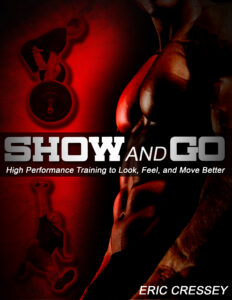
How to Select a Weight to Use in a Resistance Training Program
The question of what weight to use in a resistance training program comes up very commonly not only among beginners, but also intermediate and experienced lifters. So, when I got this question from a reader recently, it gave me the kick in the pants I needed to cover this in a detailed write-up.
Q: I have a question about how to select weights to use within programs like yours that may fluctuate the sets and reps from week to week. For example, if it’s 4×3 in week 1, 4×2 in week 2, 4×4 in week 3, and 3×3 in week 4, are there are certain percentages that I can use based off my one-rep max? This would make it easier to know exactly what weight to use each week.
A: Rather than reinvent the wheel, I’m going to paraphrase a bit from chapter 2 of the Show and Go main guide. Let me preface this explanation by saying that the goal of all my programs – and indeed any good strength and conditioning program – is to get stronger. And, I fully expect you to do so.
Now, if that’s the case, it doesn’t make a whole lot of sense to select what weight to use based on percentages of one-rep maxes that were taken before the program even began. By the time you get to phases 2, 3, and 4, you aren’t going to have sufficient overload to make optimal progress.
So, to that end, I rarely assign training percentages. All sets should be to one rep shy of failure; basically, go hard but never attempt a rep that you won’t complete on your own. Each session should be somewhat of a test of your new strength as you work up to heavier loads and listen to your body along the way.
As a frame of reference, on your first (main) exercise(s), just work up to your heaviest set of the day (in perfect form, of course), and then find 90% of it. Anything you did above that 90% number “counts” as a set. Anything done before it is a warm-up. So, imagine you had 4 set of 3 reps planned on the bench press, and you worked up to 300 on you heaviest set using the following progression:
Set 1: 45×8
Set 2: 135×5
Set 3: 185×3
Set 4: 225×3
Set 5: 275×3
Set 6: 295×3
Set 7: 300×3
That puts you at three sets (275, 295, and 300) above 90% of your heaviest load for the day (300). So, to get a fourth set in, you just need to get one more set somewhere between 270 (90%) and 300 (100%). By the next week, this 90-100% range may have shifted up by 5-10 pounds, so you have to accommodate it – and prescribing percentages on an old one-rep-max just doesn’t do the job justice.
It really doesn’t matter what rep range is in question – whether you’re doing heavy singles or a 5×5 workout. You can really apply it to just about every set in every training session when you’re wondering what weight to use.
For more information, check out Show and Go: High Performance Training to Look, Feel, and Move Better.
Sign-up Today for our FREE Newsletter and receive a deadlift technique video!




